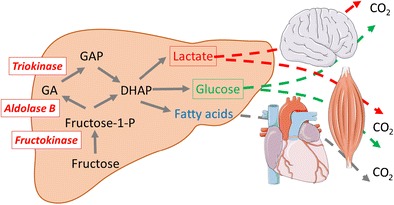Fig. 1.

Unlike glucose, which can be used as an energy substrate by all human cells, fructose cannot be directly metabolized by most cells due to a much lower affinity of hexokinases for fructose than for glucose. Instead, fructose is first metabolized in a limited number of organs (liver, small intestinal mucosa, kidney). In these organs, it is metabolized to trioses-phosphate (di-hydroxyacetone-phosphate and glyceraldehyde-3-phosphate) by a set of specific enzymes: fructokinase (ketohexokinase), aldolase B, and triokinase. Trioses-phosphate can subsequently be further converted into ubiquitous energy substrates: lactate, glucose, and fatty acids (palmitate, oleate, stearate, …)
